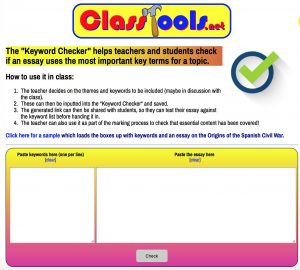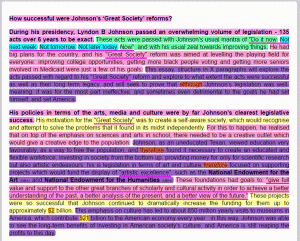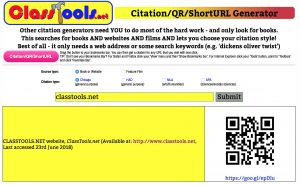Overview
Essay-writing skills in history are crucially important to develop but notoriously difficult to measure in final exams. Although official mark schemes provide general guidance for examiners about the main arguments and evidence that might be included, individual examiners still have some latitude to express their own subjective judgements about what constitutes the perfect blend of fact and opinion, of argument and evidence, of narrative and analysis. History is therefore a subject in which there is, strictly speaking, no ‘correct answer’ either in terms of opinions expressed by the writer, or the style of writing itself.
Nevertheless, there are still certain key elements that characterise more effective essay-writing that can be objectively measured, and as such I am continually intrigued by the prospect of how automated, computer-based tools might help improve the essay writing process. With this in mind, I have developed several freely-available online tools that can be used to help students draft their essays and for teachers to then mark them.
Keyword Checker 
This tool allows you to copy and paste a typed essay into one box, a list of key terms (organised under headings, if you wish) and then gives you a quick summary of which words have been included and which have not, along with an overall percentage rating. Although a simple tool, it has proven remarkably popular with my own students. The way I tend to use it is to discuss and agree with the students in advance which are the key themes that will need to be covered (for breadth) and which particular key words, phrases, quotes and statistics we will aim to include. The students then take this list away with them and can use it along with the keyword checker to help frame their own essay before handing it in.
EyeSay! 
This is a development of the previous tool, providing students with particular tips regarding issues of style and structure. Once again, students simply paste their essay into the interface. This time, though, the computer then runs a detailed analysis and ratings based around the use of quotes, statistics, sentence lengths, range of vocabulary, linkage between paragraphs and so on. The essay can be edited directly within the application and continually re-assessed by the computer to provide a running commentary. Whilst it cannot replace teacher marking, and remains a tool which I will continue to tweak and develop, it can nevertheless throw up some interesting insights and provoke some interesting discussions. The title of the application “EyeSay!” reflects the fact that its most novel feature is that it converts essays into a veritable riot of colour by highlighting different features in different hues. It’s even possible to reduce the entire essay to blocks of colour, which could lead to some particularly lively debate about what a good essay should literally ‘look’ like, not to mention a strikingly original classroom display.
Citation Generator
Effective and accurate citations are an important part of extended essay writing and can often cause a lot of confusion and heartache for students. Although many online tools exist to create citations, I always found them rather cumbersome since they input so many pieces of information that it takes longer than writing the citation from first principles. So I coded this simple tool, through which students can simply provide a web address, author, film or book name and then obtain a citation in a whole range of formats (MLA, APA, Chicago, HAD…). There is also the facility to add a ‘bookmarklet’ to your web browser so that a citation can automatically be generated for any web page currently being visited.
Taking it further
- The keyword checker could check not just for topic-specific terminology: consider using it also to encourage students to use linkage words (e.g. nevertheless, however, notwithstanding, consequently) within their writing.
- The EyeSay! application could be used to analyse existing articles written by professional historians and provide further insights into what constitutes good writing (not to mention the limitation of computer-based tools for measuring this!). It is also possible to view the essay’s opening topic sentences in isolation. If these thesis statements are written well, then taken together they should provide a coherent overview of the entire argument. If not, they should be edited further.


